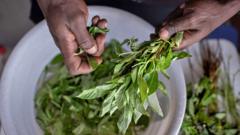The culinary landscape in Kenya is shifting as once-overlooked indigenous vegetables gain recognition for their health benefits and flavor. Following years of decline, their popularity is rising, leading to a greater demand in restaurants and a renewed focus on organic farming practices.
Reviving Culinary Heritage: Kenya's Indigenous Vegetables Flourish

Reviving Culinary Heritage: Kenya's Indigenous Vegetables Flourish
Once discarded as mere weeds, indigenous leafy greens are now celebrated for their nutritional benefits in Kenya's restaurants and markets.
Despite their historical dismissal as "poor man's food," indigenous vegetables like managu and terere are reinventing culinary traditions across Kenya. Once regarded as mere weeds, these nutrient-rich greens are now embraced by chefs and consumers alike, citing their health benefits and superior taste.
Skinners Restaurant, located just outside Nairobi, has been at the forefront of this movement. Employee Kimani Ng'ang'a points out that many diners actively request "kienyeji," the local term for native vegetables, despite the higher prices they command due to sourcing difficulties. This growing awareness reflects a broader trend among Kenyans advocating for locally grown, organic varieties over imported greens like cabbage and spinach.
Health professionals also endorse the consumption of indigenous vegetables, attributing detoxifying properties and weight loss benefits to staples such as managu, which is noted for its higher vitamin and mineral content compared to its more common counterparts.
For years, indigenous vegetables were ridiculed; Professor Mary Abukutsa-Onyango recounts her challenges in promoting these crops during her academic career, historically referred to as weeds. This has significantly changed; in the last decade, local greens' production has surged, contributing to food security in the region.
The growing interest in indigenous diets is highlighted by developments such as UNESCO's recognition of Kenya's efforts to safeguard its culinary heritage. Ongoing projects are compiling inventories of traditional plants, with nearly 850 varieties now documented.
While established crops like sukumawiki still dominate with impressive production levels, progressive farmers are reclaiming native varieties. Farmers like Francis Ngiri are leading this revolution by transitioning towards organic farming techniques, fostering biodiversity, and preserving ancient practices.
However, challenges persist. The introduction of strict seed certification laws limits farmers' ability to exchange and access indigenous seeds, a barrier raised by activists who combat the loss of cultural crops. Organizations like Seed Savers Network are crucial, assisting local farmers in emergency seed conservation efforts to prevent extinction of traditional varieties.
Despite these obstacles, there is palpable momentum as local markets see increasing demand for kienyeji. Vendors like Priscilla Njeri attest to the popularity of these greens among consumers eager for healthier, tastier options.
As Kenya continues to navigate the balance between modern agriculture and traditional food practices, the revival of indigenous vegetables serves as a testament to cultural resilience and the vital importance of biodiversity for future generations. This culinary renaissance brings with it not just a rich economic opportunity but also a chance to reconnect with cultural heritage and the environment.
Skinners Restaurant, located just outside Nairobi, has been at the forefront of this movement. Employee Kimani Ng'ang'a points out that many diners actively request "kienyeji," the local term for native vegetables, despite the higher prices they command due to sourcing difficulties. This growing awareness reflects a broader trend among Kenyans advocating for locally grown, organic varieties over imported greens like cabbage and spinach.
Health professionals also endorse the consumption of indigenous vegetables, attributing detoxifying properties and weight loss benefits to staples such as managu, which is noted for its higher vitamin and mineral content compared to its more common counterparts.
For years, indigenous vegetables were ridiculed; Professor Mary Abukutsa-Onyango recounts her challenges in promoting these crops during her academic career, historically referred to as weeds. This has significantly changed; in the last decade, local greens' production has surged, contributing to food security in the region.
The growing interest in indigenous diets is highlighted by developments such as UNESCO's recognition of Kenya's efforts to safeguard its culinary heritage. Ongoing projects are compiling inventories of traditional plants, with nearly 850 varieties now documented.
While established crops like sukumawiki still dominate with impressive production levels, progressive farmers are reclaiming native varieties. Farmers like Francis Ngiri are leading this revolution by transitioning towards organic farming techniques, fostering biodiversity, and preserving ancient practices.
However, challenges persist. The introduction of strict seed certification laws limits farmers' ability to exchange and access indigenous seeds, a barrier raised by activists who combat the loss of cultural crops. Organizations like Seed Savers Network are crucial, assisting local farmers in emergency seed conservation efforts to prevent extinction of traditional varieties.
Despite these obstacles, there is palpable momentum as local markets see increasing demand for kienyeji. Vendors like Priscilla Njeri attest to the popularity of these greens among consumers eager for healthier, tastier options.
As Kenya continues to navigate the balance between modern agriculture and traditional food practices, the revival of indigenous vegetables serves as a testament to cultural resilience and the vital importance of biodiversity for future generations. This culinary renaissance brings with it not just a rich economic opportunity but also a chance to reconnect with cultural heritage and the environment.




















